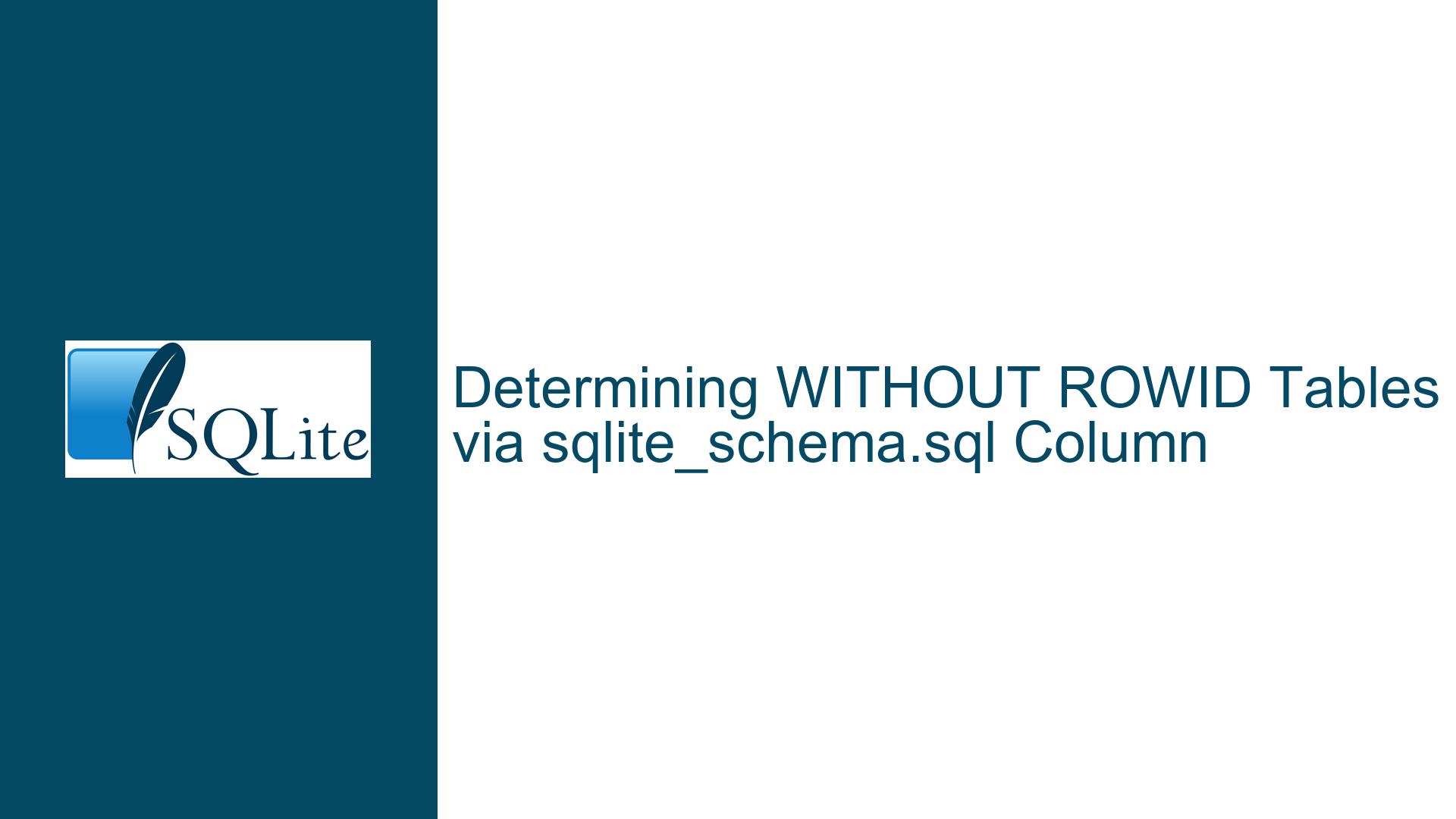Determining WITHOUT ROWID Tables via sqlite_schema.sql Column
Understanding the Role of sqlite_schema.sql in Identifying WITHOUT ROWID Tables
Issue Overview
The core issue revolves around determining whether an existing SQLite table is defined as a WITHOUT ROWID table. The SQLite documentation currently describes a method for identifying such tables by querying the sqlite_schema table’s type and name columns. However, the documentation does not explicitly mention that the sql column of the sqlite_schema table contains the original CREATE TABLE statement, which includes the "WITHOUT ROWID" clause if present. This omission has led to confusion for users who expect the sql column to serve as a reliable source of truth for schema introspection.
SQLite’s WITHOUT ROWID optimization alters the physical storage format of a table by omitting the implicit rowid column, which can improve performance and reduce storage overhead for tables with a primary key. The recommended method for detecting such tables involves checking for the absence of a sqlite_schema entry where type='table' and name matches an internal index. However, the sql column in sqlite_schema stores the original SQL definition of the table, which could theoretically be parsed to detect the presence of the "WITHOUT ROWID" clause.
The debate centers on whether the sql column should be considered a stable, sanctioned mechanism for detecting WITHOUT ROWID tables. While the sqlite_schema table is part of SQLite’s schema representation, its structure and the contents of its sql column are not formally guaranteed to remain consistent across SQLite versions. This creates tension between practical utility (using the sql column for simplicity) and adherence to documented, stable interfaces (relying on indirect methods like the type and name checks).
Possible Causes of Confusion and Risk
Ambiguity in sqlite_schema.sql’s Stability:
Thesqlite_schematable is documented in SQLite’s schema table guide, but itssqlcolumn is described as containing a "normalized" version of the original CREATE statement. Normalization includes formatting changes, such as whitespace removal and keyword capitalization, which could theoretically evolve in future SQLite versions. This lack of explicit guarantees about thesqlcolumn’s format discourages its use in application code, even though it appears to contain the necessary information.Divergent Approaches to Schema Introspection:
SQLite provides multiple ways to introspect schema metadata, including virtual tables likesqlite_master(a synonym forsqlite_schema) and pragmas liketable_info. However, the recommended method for detecting WITHOUT ROWID tables avoids direct parsing of thesqlcolumn, instead relying on the presence or absence of specificsqlite_schemaentries. This inconsistency between intuitive parsing (checking thesqlcolumn) and sanctioned methods (checkingtypeandname) creates friction for developers.Documentation Gaps and Implied Stability:
The SQLite documentation for thesqlite_schematable acknowledges its existence and structure but does not explicitly warn against parsing thesqlcolumn for critical schema details. This omission, combined with the table’s visibility in database files, leads some users to assume that querying thesqlcolumn is a valid approach. Meanwhile, the documentation for WITHOUT ROWID tables omits mention of thesqlcolumn, reinforcing the perception that it is not a supported method.Backward Compatibility vs. Implementation Flexibility:
SQLite’s developers prioritize backward compatibility for database file formats but reserve the right to change internal implementation details. While thesqlite_schematable’s structure is unlikely to change drastically (due to its role in the file format), the contents of thesqlcolumn are subject to normalization rules that could evolve. This creates a risk for applications that parse thesqlcolumn, as future SQLite versions might alter its formatting in ways that break existing parsing logic.
Troubleshooting Steps, Solutions, and Mitigations
Step 1: Use Officially Recommended Methods for Schema Introspection
The safest way to determine if a table is WITHOUT ROWID is to use the method described in SQLite’s documentation:
SELECT COUNT(*)=0 FROM sqlite_schema
WHERE type='table' AND name='<table_name>_WITHOUT_ROWID';
This query checks for the absence of a specially named internal index, which is created only for WITHOUT ROWID tables. While indirect, this method avoids parsing the sql column and relies on stable, documented behavior.
Step 2: Avoid Reliance on sqlite_schema.sql for Critical Logic
Although the sql column contains the original CREATE TABLE statement, parsing it introduces fragility. For example, future versions of SQLite might normalize the statement further (e.g., removing comments, reordering clauses), which could break regex-based searches for "WITHOUT ROWID". Instead, treat the sql column as a human-readable reference rather than a machine-parsable source.
Step 3: Leverage PRAGMA Statements for Metadata
SQLite’s PRAGMA table_info and PRAGMA index_list commands provide structured metadata about tables and indexes. While these do not directly indicate whether a table is WITHOUT ROWID, they can help infer it indirectly. For example, a WITHOUT ROWID table will have a primary key that is also a covering index, which can be detected via:
PRAGMA index_list('<table_name>');
Look for an index with a name matching the table’s primary key and origin='pk'. This approach avoids relying on sqlite_schema entirely.
Step 4: Propose Documentation Updates to Clarify Risks
To reduce confusion, the SQLite documentation could be updated with a caveat explaining that while the sql column contains the "WITHOUT ROWID" clause, parsing it is not recommended due to normalization risks. A brief example could be added to the "Determining If An Existing Table Is WITHOUT ROWID" section, followed by a note encouraging the use of the index-checking method.
Step 5: Advocate for a New Metadata Interface
If detecting WITHOUT ROWID tables programmatically is a common need, propose extending SQLite’s pragmas or virtual tables to expose this property directly. For example, a PRAGMA table_options('<table_name>') command could return a result set including a without_rowid flag. This would eliminate the need for workarounds and provide a stable interface.
Step 6: Validate Assumptions with Regression Tests
For applications that already parse the sql column, implement regression tests that check for the presence of "WITHOUT ROWID" across multiple SQLite versions. This helps detect normalization changes early. However, recognize that such tests cannot future-proof the application, as SQLite’s normalization rules are not part of its API guarantees.
Conclusion
The debate over using sqlite_schema.sql to detect WITHOUT ROWID tables highlights a broader challenge in SQLite development: balancing implementation flexibility with user expectations. While the sql column appears to offer a straightforward solution, its lack of formal guarantees makes it unsuitable for production-critical code. By adhering to documented methods and advocating for enhanced metadata interfaces, developers can achieve reliable schema introspection without depending on unstable implementation details.






